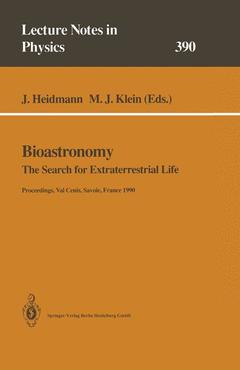Bioastronomy, Softcover reprint of the original 1st ed. 1991 The Search for Extraterrestrial Life — The Exploration Broadens Coll. Lecture Notes in Physics, Vol. 390
Langue : Français
Coordonnateurs : Heidmann Jean, Klein Michael J.

This book collects together a selection of the best papers presented at the Third International Bioastronomy Symposium held in 1990. The subject is bioastronomy, the search for life in the universe, andthe book is devided according to the five main stages of life as recognized by this new branch of science: cosmic organic, prebiotic, primitive biological, and advanced. Thereader will find here the most recent results obtained by top specialists from all over the world on hot topics such as the formation and discovery of planets, organic chemistry in meteorites and comets, prebiotic chemistry in the atmosphere of Titan, the search for primitive life in the permafrost of Mars, and, SETI itself, the search for extraterrestrial intelligence. Complemented by live discussions each presentation forms a review of the state-of-the-art treatment of a particular area and also looks toward those developments in bioastronomywhich will surely be realized in the next few years.
Opening remarks.- The creation of free energy.- Particulate disks around main sequence stars.- Bursts of star formation in the local galactic disk and their implications for the origin and evolution of life around the sun and nearby stars.- Testing theories of star formation.- Towards an estimate of the fration of stars with planets from velocities of high precision.- On the feasibility of extra-solar planetary detection at very low ratio frequencies.- The ESO microvariability Key Program and the detection of extrasolar planets and brown dwarfs.- A proposal for the search of extrasolar planets by occultation.- Near-term prospects for extra-solar planet detection: The astrometric imaging telescope.- A search for T-Tauri stars based on the IRAS Point Source Catalog.- How many single stars among solar-type stars?.- Habitable planetary orbits around ? centauri and other binaries.- The search for protostars.- The habitability of Mars-like planets around main sequence stars.- Planetary accretion debris and IR excesses in open stellar clusters.- Lithium abundances as a probe of the early evolution of solar-type stars.- Low-amplitude stellar velocity variations: Other possibilities.- Some recent developments in interstellar chemistry.- The formation of long chains of carbon atoms in space.- Hydrogen cyanide polymerization: A preferred cosmochemical pathway.- PAHs: Very abundant organic molecules in the interstellar medium.- Primitive evolution: Early information transfer and catalysis by purines.- The search for H2O in extraterrestrial environments.- Self-assembly properties of primitive organic compounds.- Cometary studies: Bioastronomical perspectives.- Origin of the biosphere of the earth.- Carbon-rich micrometeorites and prebiotic synthesis.- Titan's atmosphere probed bystellar occultation.- Study of transmitted light through Titans atmosphere.- UV radiation fields in dense clouds: Photochemical effects.- Prebiotic chemistry in planetary environments.- Terrestrial accretion of prebiotic volatiles and organic molecules during the heavy bombardment.- Geophysiology and habitable zones around sun-like stars.- Exobiological habitats: An overview.- Habitable zones for earth-like planets around main sequence stars.- Titan's atmosphere from voyager infrared observations: Parallels and differences with the primitive earth.- Liquid water and life on early mars.- New interpretation of crustal extension evidences on mars.- Martian paleohydrology and its implications for exobiology science.- Boundaries of the earth's biosphere.- The impact of technology on SETI.- RFI surveys at selected radio observatories.- A 1 Hz resolution RFI survey: Preliminary results.- The SERENDIP II SETI project: Observations and RFI analysis.- SETI: On the telescope and on the drawing board.- Project of ETI signal search at the wavelength 1.47 mm.- A SETI search technique: Monitor stars to which we have sent signals.- Radio search for alien space probes.- Karhunen-Loève versus Fourier transform for SETI.- On the strategy of SETI.- Pan-Galactic puise periods and the pulse window for SETI.- Cosmic background radiation limits for SETI.- VLBI and interstellar scattering tests for SETI signals.- A test for the interstellar contact channel hypothesis in SETI.- The SETI program of the Planetary Society.- Trying to do science using high spectral resolution SETI prototypes.- The summit of the CBR at mm wavelengths and other queries.- The potential contribution of the northern cross radiotelescope to the SETI program.- A proposal for a SETI global network.- A search for Dysonspheres around late-type stars in the Iras catalog.- Gravitational, plasma, and black-hole lenses for interstellar communications.- SETI through the gamma-ray window: A search for interstellar spacecraft.- Criteria of artificiality in SETI.- The antecedents of consciousness: Evolving the “intelligent” ability to simulate situations and contemplate the consequences of novel courses of action.- Cognition in an African Grey parrot.- Archaeology in space: Encountering Alien Trash and other remains.- Biological constraints on interstellar travel.- A philosophical approach to the extraterrestrial life issue.- The intrinsic limit to the speed of innovation and its relevance for the question “where are they?”.- SETI searches with the 70m SUFFA radio telescope.- Strategy of the mutual search for civilizations by means of probes.- Connections: Life on Earth and atoms in the Universe.- From the physical world to the biological universe: Historical developments underlying SETI.- A possible way for evolution of the intellect of intelligent beings.- SETI as a science.- May there be an ultimate goal to the cosmic evolution?.- Evolutionary approach to the SETI problem.- Peace among the factions: Cooling tempers in the extraterrestrial life debate.- The likely organizational order of advanced intelligences.- The role of comprehensive perception in tradition.- Technical evolution and positive feedback.- Contact paranoia and pronoia: An anthropologist looks at SETI.- The declaration of principles for activities following the detection of extraterrestrial intelligence.- The consequences of contact: Views of the scientific community and the science media.- Selection criteria in bioastronomy: Excerpts from a panel discussion.- Summary of scientific content of the symposium.
Date de parution : 08-2014
Ouvrage de 413 p.
17x24.4 cm
Thème de Bioastronomy :
Mots-clés :
Bioastronomie; Radioastronomie; Weltraum; astronomy; ausserirdisches Leben; bioastronomy; extraterrestrial life; space
© 2024 LAVOISIER S.A.S.



